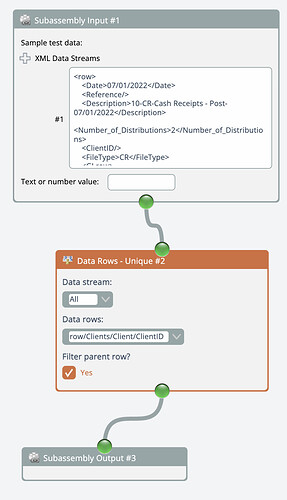I think i know the answer but wanted to check. Using the data rows - unique module, is there anyway to apply it to the parent record only and ensure unique children only in that one parent?
example
t>
<data>
<row>
<Date>07/01/2022</Date>
<Reference/>
<Description>10-IN-Invoices - Posted 07-07/01/2022</Description>
<Number_of_Distributions>79</Number_of_Distributions>
<ClientID>000286</ClientID>
<FileType>IN</FileType>
<Clients>
<Client>
<ClientID>000286</ClientID>
</Client>
<Client>
<ClientID>000286</ClientID>
</Client>
<Client>
<ClientID>000286</ClientID>
</Client>
<Client>
<ClientID>000286</ClientID>
</Client>
<Client>
<ClientID>000286</ClientID>
</Client>
<Client>
<ClientID>000231</ClientID>
</Client>
<Client>
<ClientID>000231</ClientID>
</Client>
<Client>
<ClientID>000231</ClientID>
</Client>
<Client>
<ClientID>000231</ClientID>
</Client>
<Client>
<ClientID>000212</ClientID>
</Client>
<Client>
<ClientID>000212</ClientID>
</Client>
<Client>
<ClientID>000212</ClientID>
</Client>
<Client>
<ClientID>000212</ClientID>
</Client>
</Clients>
</row>
</data>
<data>
<row>
<Date>07/01/2022</Date>
<Reference/>
<Description>10-CR-Cash Receipts - Post-07/01/2022</Description>
<Number_of_Distributions>2</Number_of_Distributions>
<ClientID/>
<FileType>CR</FileType>
<GLrow>
<GL_Account>10100</GL_Account>
<Location>10</Location>
<ProjectID/>
<ClientID/>
<ClassID/>
<EmployeeID/>
<Amount>461001.46</Amount>
<tranType>1</tranType>
</GLrow>
<GLrow>
<GL_Account>11001</GL_Account>
<Location>10</Location>
<ProjectID/>
<ClientID/>
<ClassID/>
<EmployeeID/>
<Amount>461001.46</Amount>
<tranType>-1</tranType>
</GLrow>
<Clients>
<Client>
<ClientID>000212</ClientID>
</Client>
<Client>
<ClientID>000212</ClientID>
</Client>
</Clients>
</row>
</data>
</root>]
within each “row” there is a “clients” node. there are repeating clientIDs that needs to be unique but only unique to that “row”. in the sample data 000212 exists in both rows.
currently if i run the unique module, that second row’s 000212 values are removed since it already exists in the first “row”. Is there a way to use the unique value that way? if not I assume i would have to create an array or hash table when building out this dataset and unique values that way.
